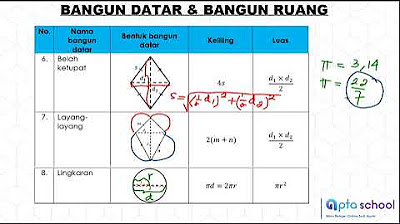Year 7 Maths | 3D Solids Prisms Pyramids
Summary
TLDRThis educational video script delves into the world of three-dimensional shapes, focusing on prisms and pyramids. It explains that prisms, including rectangular, square, triangular, pentagonal, and trapezoidal, share common features like faces, edges, and vertices. The script then contrasts pyramids, which are characterized by an apex and two types of heights: slant and vertical. It emphasizes the importance of understanding these features for calculating surface area and volume. The script also mentions other solids like cylinders and spheres, which, while not fitting into the prism or pyramid categories, are equally important in geometry.
Takeaways
- 📐 Solids are three-dimensional shapes with length, width, and depth.
- 🏗️ Solids are primarily categorized into two families: prisms and pyramids.
- 🔲 Prisms include rectangular prisms, cubes, triangular prisms, pentagonal prisms, and trapezoidal prisms.
- 🟦 Prisms are characterized by their faces, which can be rectangles, squares, triangles, or pentagons.
- 🔺 Prisms also have edges and vertices (corners), which are essential features for understanding their structure.
- 🏰 Pyramids are distinguished by having an apex, which is the sharp top point of the pyramid.
- ⛰️ Pyramids have two types of heights: slant height (sloping) and vertical height (from apex to the center of the base).
- 🔼 Pyramids are named based on the shape of their base, such as square, triangular, or pentagonal pyramids.
- 📏 Pyramids have triangular faces surrounding the base, which is a common feature among them.
- 🌐 Besides prisms and pyramids, there are other solids like cylinders and spheres that don't fit into these two families.
Q & A
What are the two main families of solids discussed in the script?
-The two main families of solids discussed in the script are prisms and pyramids.
What are the characteristics that all prisms share?
-All prisms share the characteristic of having faces, edges, and vertices. They also have a base shape that determines their specific type, such as rectangular, square, triangular, pentagonal, or trapezoidal.
What is the difference between a rectangular prism and a cube?
-A rectangular prism has rectangular faces, while a cube is a special type of rectangular prism where all faces are squares.
Why is the pentagonal prism named so?
-The pentagonal prism is named so because its main face, or cross-section, is a pentagon.
What is the term for the corners of a solid shape?
-The term for the corners of a solid shape is 'vertices', with 'vertex' being the singular form.
What is the defining feature of all pyramids?
-The defining feature of all pyramids is the presence of an apex, which is the sharp top point of the pyramid.
What are the two types of heights mentioned for pyramids and what are they called?
-The two types of heights for pyramids are the slant height, which is the slanting height, and the vertical height, which is the height from the apex down to the center of the pyramid's base.
How are pyramids named based on their base?
-Pyramids are named based on their base shape; for example, a pyramid with a square base is called a square pyramid, and one with a triangular base is called a triangular pyramid.
What is the significance of understanding the difference between slant height and vertical height in pyramids?
-Understanding the difference between slant height and vertical height in pyramids is significant for calculating the surface area and volume of pyramids.
Are there any other solids mentioned in the script that do not fit into the prism or pyramid families?
-Yes, the script mentions cylinders and spheres as examples of solids that do not fit into the prism or pyramid families.
Why are the properties of prisms and pyramids important for future studies?
-The properties of prisms and pyramids are important for future studies because they are used extensively when working with volume and surface area calculations.
Outlines

Cette section est réservée aux utilisateurs payants. Améliorez votre compte pour accéder à cette section.
Améliorer maintenantMindmap

Cette section est réservée aux utilisateurs payants. Améliorez votre compte pour accéder à cette section.
Améliorer maintenantKeywords

Cette section est réservée aux utilisateurs payants. Améliorez votre compte pour accéder à cette section.
Améliorer maintenantHighlights

Cette section est réservée aux utilisateurs payants. Améliorez votre compte pour accéder à cette section.
Améliorer maintenantTranscripts

Cette section est réservée aux utilisateurs payants. Améliorez votre compte pour accéder à cette section.
Améliorer maintenant5.0 / 5 (0 votes)






